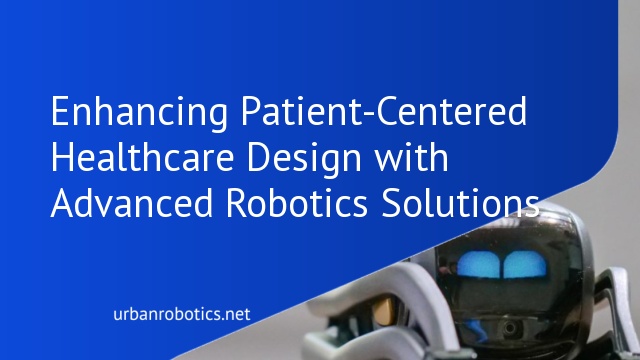Overview of Patient-centered Healthcare Design
Patient-centered healthcare design aims to address both practical and emotional needs. It emphasizes empathetic interactions and personalized care. Recent trends show that integrating robotics plays a crucial role in achieving these goals.
Robotics improve patient care by reducing human error and enabling more precise treatments. For example, robotic surgical systems allow for minimally invasive procedures, leading to faster recovery times. Additionally, robots assist in routine tasks like medication administration, reducing workload for healthcare professionals.
Patient experience also benefits from innovative designs. Autonomous robots can navigate healthcare facilities, guiding patients and providing relevant information. This reduces stress and enhances overall satisfaction. Implementing such technologies demonstrates a commitment to improving patient outcomes and well-being.
Data from a 2022 survey by HIMSS Analytics shows that 59% of healthcare institutions are adopting robotics to enhance patient-centered care. This adoption trend highlights the importance of investing in technologies that prioritize patient needs. Our focus remains on creating environments where technology and compassion coexist seamlessly for optimal healthcare delivery.
The Role of Robotics in Healthcare
Robots play a pivotal role in modern healthcare, aligning with patient-centered design principles to improve precision and efficiency.
Types of Healthcare Robots
Different types of healthcare robots enhance patient care and streamline hospital operations.
- Surgical Robots: Systems like da Vinci guide surgical procedures with higher precision.
- Service Robots: Machines such as TUG robots deliver medication and supplies.
- Rehabilitation Robots: Devices like Lokomat assist in patient recovery and mobility.
- Telepresence Robots: Units like VGo enable remote consultations and virtual visits.
- Sanitization Robots: Examples include UV-light robots, which disinfect hospital spaces.
Benefits of Robotics in Healthcare
The integration of robotics offers numerous advantages in healthcare settings.
- Enhanced Precision: Robotic systems minimize human error during surgeries and procedures.
- Increased Efficiency: Robots handle routine tasks, freeing up healthcare professionals for critical care.
- Improved Recovery: Rehabilitation robots aid faster, more effective patient recoveries.
- Patient Safety: Sanitization robots reduce infection risks, promoting a safer environment.
- Remote Access: Telepresence robots offer accessible, immediate patient consultations and monitoring.
Key Features of Patient-centered Robotics
Patient-centered robotics emphasizes features that directly improve patient care and interaction.
Customization and Adaptability
Robotic systems must cater to diverse patient needs. Customizable settings ensure robots adapt to individual preferences, improving comfort and effectiveness. For example, rehabilitation robots like Lokomat adjust to different patient heights and strengths, providing personalized therapy. Surgical robots offer customizable tools and settings for various procedures, enhancing surgeon precision and patient outcomes. Customization and adaptability enhance the overall patient experience by making interactions with robotic systems more seamless and tailored.
User-friendly Interfaces
User-friendly interfaces are crucial for patient-centered robotics. Simplified controls and intuitive touchscreens make it easy for healthcare professionals and patients to interact with robots. Clear visual cues and voice commands facilitate straightforward navigation, even for those with limited technical skills. For instance, telepresence robots, such as VGo, employ easy-to-use interfaces enabling smooth remote consultations. Ensuring robots are accessible and easy to use reduces barriers and encourages their adoption in clinical settings.
Safety and Reliability
Safety and reliability stand at the forefront of patient-centered robotics. Built-in sensors prevent collisions, ensuring safe operation around patients and staff. For instance, UV-light sanitization robots stop instantly if someone enters their cleaning zone. Redundant systems and self-diagnostic checks ensure continuous reliability and minimize downtime. Safety certifications from authoritative bodies validate the robots’ compliance with strict standards. Ensuring high safety and reliability levels instills confidence and trust in both patients and healthcare providers.
Case Studies and Examples
Successful Implementations
Implementation of robotics in healthcare has shown promising results. Massachusetts General Hospital uses the da Vinci Surgical System. Surgeons perform precise, minimally invasive surgeries, reducing recovery times. The Mayo Clinic employs TUG robots for task automation, improving hospital workflow and freeing staff for patient care. Lokomat rehabilitation robots aid in physical therapy at the Craig Hospital, enhancing patient mobility outcomes.
Challenges Faced
Despite successes, challenges exist in integrating robotics into healthcare. High initial costs and ongoing maintenance can deter adoption. Interoperability with existing systems poses technical difficulties, requiring extensive customization. There’s also user skepticism—patients and staff need assurance about reliability and safety, demanding rigorous training and iterative improvements.
Future Trends in Patient-centered Robotics
Increased advancements in AI, machine learning, and telemedicine will redefine patient-centered healthcare. Robotics will become more intuitive and integrated into daily care routines.
Advancements in AI and Machine Learning
AI and machine learning enhance robotics capabilities in patient-centered design. Algorithms enable robots to learn from vast datasets, allowing them to predict patient needs and personalize treatments. For example, AI-powered robots can monitor vital signs and alert healthcare providers to early signs of health deterioration. Advanced machine learning frameworks also streamline administrative tasks, reducing the burden on medical staff and improving patient engagement.
Integration with Telemedicine
Robotics integration with telemedicine expands the reach of healthcare services. Telepresence robots, combined with advanced diagnostics tools, allow us to deliver high-quality care remotely. Patients in rural areas or with mobility issues can receive timely consultations and follow-ups. Integrating robotics enhances real-time data sharing, enabling continuous patient monitoring without physical hospital visits. This integrated approach not only improves access but also ensures consistent and personalized patient care.
Conclusion
Patient-centered healthcare design with robotics is transforming how we approach medical care. By focusing on the holistic needs of patients, these advanced technologies are enhancing both the quality and accessibility of care. Robotics, powered by AI and machine learning, are becoming more intuitive, offering personalized treatments and efficient monitoring.
As we continue to integrate these innovations into daily healthcare routines, we’re not just improving patient outcomes but also expanding the reach of medical services. This progress ensures that everyone, regardless of location or mobility, can access high-quality, personalized care. The future of healthcare is bright, and robotics are at the forefront of this transformative journey.





